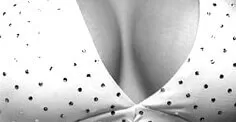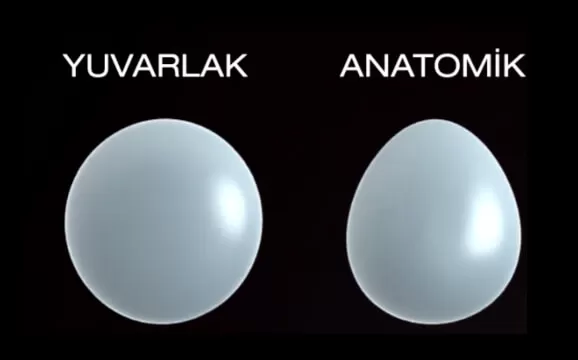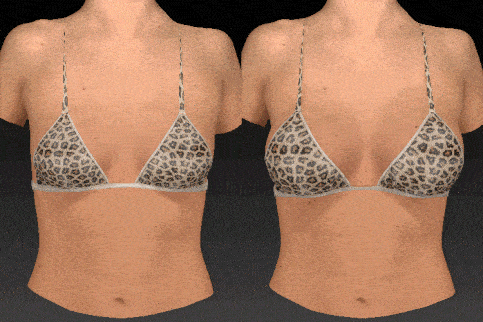

As a symbol of fertility and femininity in almost all cultures, breasts play a major role in women’s social life and psychology. Women who experience volume loss in their breasts due to congenital factors, age, weight loss, pregnancy and tissue loss after breast cancer can achieve the desired size and shape of their breasts with breast augmentation surgery.
The most preferred breast augmentation surgery worldwide is also the plastic surgery operation with the fewest complications.
In the literature, breast augmentation surgery can be performed with two main methods; breast implant and fat injection. Breast augmentation with fat injection can give successful results if the breast structure is appropriate, but breast implant is recommended as the first choice in most scenarios due to its permanence.

1- Under the breast: The incision under the breast is made in harmony with the natural curve under the breast and unlike other parts of the body, the incision scar here does not expand. All structures leading to the nipple (milk duct, nerves, veins, etc.) are preserved and remain unchanged.
In addition, once the incisions in other breast implant surgeries have healed, they cannot be reopened. However, the incision made in the inframammary fold (IMF) can be reused in the future.
2- Around the nipple (periareolar): The incision made in this area is usually crescent-shaped and at the transition line between the colored area and the skin to leave minimal scarring.
3- Placement of implants under the armpit: The trans-axillary incision should be made once and accurately. This is because the surgical incision cannot be made in this area again in case another breast surgery is required in the future.
Bacteria that grow under the arm and perfumes and deodorants used to suppress the odors caused by these bacteria increase the risk of infection after surgery. In addition, methods of getting rid of unwanted hair can also damage the incision wound in this area.
Breast prostheses can be placed in two different ways: submuscular (subpectoral or dual plane) or supramuscular (subglandular or submammary).
1- Under Muscle: In this approach, the implant is placed between the chest muscle and the chest wall. This approach usually provides a more natural look, but the recovery time is usually a little longer.
2- Above the Muscle: In this case, the implant is placed over the breast tissue and chest muscle. This approach usually provides a faster healing process, but there is a risk of the implant being prominent
.
If you are wondering which technique is more suitable for you, you can have a free examination by clicking the button below.


When Hawaii is mentioned, the sea, the sun... Read more

A report by The Sun newspaper Read more

Latin beauty is full and rounded... Read more

A survey by The Sun newspaper... Read more
In breast augmentation operations, 2 types of implants are generally used; silicone implants and saline implants.
Silicone implants: Silicone implants are the most popular option for breast augmentation because they provide a natural feel and look. These implants come in various sizes and are filled with a gel-like silicone. Silicone implants are the type of implant that provides the closest feeling to natural breast tissue.
Saline implant: This type of implant, which consists of a silicone shell filled with sterile saline, is safer against the risk of implant bursting. It is safer because the water inside will be absorbed by the body, but it feels less natural than other types of implants.

Implants used in breast augmentation come in two different forms;
Round Implant and Anatomical (Drop) Implant
Round Implant: As the name suggests, this type of implant is round in shape. Even if it rotates under the breast tissue, it does not cause deformity.
Anatomical (Drop) Implant: The drop type breast implant is also called “anatomically shaped implant”. It is also known as a water drop or teardrop implant. In fact, these terms mean that the implant is shaped in the breast form. Anatomical or “drop” shaped implants are breast implants that are shaped to mimic the shape of the breast. They are thin at the top and expand downwards, similar to the natural breast type.

“How many hours does breast augmentation take?” is one of the most important questions we hear as plastic surgeons.
The duration of breast aesthetics may vary depending on the complexity of the procedure and the surgical planning to be performed. Breast augmentation, which takes 1.5-2 hours on average, may require more time in cases that require combined or more complicated procedures such as lifting.
Generally, the patient stays in the hospital for 1 day after the procedure and can return home the next day. It will usually take 7-10 days for the swelling to subside after the operation, depending on the patient’s condition.

After the operation, Assoc. Prof. Dr. Güncel Öztürk shows you the possible image your breasts will take with the 3D Vectra device.
After receiving detailed information about the process, your operation day is determined.
After the procedure, which takes an average of 1.5 hours, you will stay in the hospital for 1 night.
Assoc. Prof. Dr. Güncel Öztürk will check you after the operation and you will be discharged.
After 5-7 days, Assoc. Prof. Dr. Güncel Öztürk provides your final control after your dressings and bandages are removed. You can say hello to a more confident life with your full breasts.
You should wear the sports bras that will be given to you after the operation for 2 months. If you have the opportunity to travel, we make sure that everything goes well by hosting you in our clinic in 1-3-6 and 12 months.
The price of breast augmentation is determined by several factors;
1- Surgeon’s Experience: The experience of the surgeon who will perform the procedure on breast augmentation will be one of the important factors affecting the price.
2- Brand of the Implant to be used: The brand of the implant to be used in breast aesthetics is also an important factor in determining the price.
3- Hospital Fees: The fees of the facility where the operation will take place will also affect the price. Factors such as hospital accommodation, anesthesia and medical expenses can also affect the cost
The mammoplasty procedure, which usually takes between 1-2 hours, may require more time in cases requiring revision (patients who have undergone previous procedures) and more complicated procedures.
The swelling will increase to the maximum level within 1 week after the operation. Afterwards, it will gradually decrease within 2-3 weeks, but it may take between 3-12 months for the breast structure to completely settle, although it varies from person to person.
Unless there is a medical necessity, breast augmentation is performed on individuals over the age of 18. The completion of breast development is the most important criterion before performing this operation.
The patient who will undergo breast augmentation must be over 18 years of age.
Placement of breast implants in the submuscular plan will make it very difficult to be noticed from the outside. Although the healing process takes a little more time, an implant placed in the submuscular dual plan will provide an image very close to the natural structure. It is also very important to choose an implant suitable for the person's body structure.
Since the implants are placed under the breast tissue and have no contact with the milk ducts, they do not interfere with breastfeeding.
The patient's body structure and expectations play an important role when choosing the implant shape in mammoplasty. According to the body proportion and the fullness desired by the patient, the surgeon will determine the ideal shape and size after the examination.
Minimal scars after breast augmentation will not disappear completely, but they will be hidden because the incisions are made in the under-breast fold. Over time, these scars take on your skin color and are difficult to notice unless you look very closely.
The durability of breast implants is stated in the literature as 10-15 years on average, but the durability of the new generation implants is still not fully determined. It is accepted that it will be longer than the previous generation implants.
Breast augmentation can be performed 2 months after the end of breastfeeding.
The patient can return to work 1 week after the operation. This period may be a little longer in jobs that require physical effort. Heavy objects etc. should not be lifted within 1 month after breast augmentation.



Copyright © 2025 Tüm Hakları Saklıdır.
SEO:
